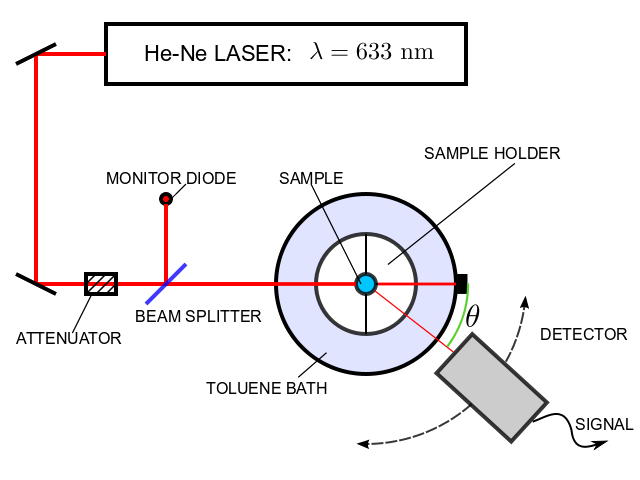

Conversely, when particles with relatively small sizes are irradiated, the laser spot pattern looks more diffuse and fuzzy. And the pattern of the laser spot appears more focused. When the radius of the particle is closer, or greater than the wavelength of the laser, most of the light travels in the direction of laser will be diffracted. According to the Mie Scattering principle, different diffraction results are generated when laser light is irradiated on particles of each sizes. This is a method for counting the average particle size of a group of particles from a macroscopic point of view, rather than actually measuring the size of a single particle. With a measurable movement speed and elapsed time, the particle's chord length (particle length along the direction of travel) can be estimated, and results the particle size. In addition, by applying a fixed-frequency pulse signal mixing measurement, the particle movement time can be measured at the same time. By the principle of a spatial filter, the moving speed of the particles is obtained. The sensor is used to sense the shadow movement of the particles. The particles are passed vertically through the transverse laser beam, and then a linear fiber array photodetector is placed at the axial end of the laser beam. Besides, either the surface is bright or dark, by this method, one can observe the texture of the surface of particles. At the same time, the particle images captured by high-speed cameras can also be used to further understand the grain thickness of the particles. And then combines evaluations by calculating equivalent spherical statistics, which are closer to actual conditions. If you would like to learn more details about these Laser Particle Size Analyzers, please visit ACTTR Technology Particle Size Analyzer product page, or contact ACTTR Technology, we will sincerely serve you! Morphological Imagingīy a high-speed video cameras to capture the appearance of particles, and measures the length, width, appearance, roundness, and crown of the particles.
#DYNAMIC LIGHT SCATTERING VS LASER DIFFRACTION FULL#
The appearance of the particles can also be observed from high speed video camera, and the measurement results can be appropriately scaled.įor measurements of particles smaller than 10nm, one can consider the " Dynamic Light Scattering" or " Taylor Dispersion Analysis" method.ĪCTTR Technology brought to you a series of full automatic particle size analyzers with great features and cost-effective solutions. Besides, most high-level laser particle size analyzers is usually assisted by the “ Morphological Imaging” method, and lead the measurement results closer to the actual conditions. According to the characteristics of the materials, the particle size analyzer can be divided into wet measurement and dry measurement. Users would most likely select a laser diffraction particle size analyzer for most of the applications. A laser diffraction particle size analizer covers the particle size of the materials above 10 nm. Particle size analysis method and applicable particle size:Īmong these particle measurement methods, the most common one with the widest size range is the laser diffraction method. Each particle size measurement technique has its best size range and which is applicable to the specific applications. The following list gives you the most common measurement techniques from different basic principles. Therefore, selecting a proper particle anzlyer, and fit to the size range of particles and applications, is a very important important prerequisite for material research. These basic technical methods can be fitted into different materials and different applications. There are a variety of particle size analyzers in the market which are based on different measurement technologies. The particle size analyzer is a special instrument which is used to measure the particle size. BT2600 …ㄡModulized Particle Analyzer + Wet Disperser Particle Size Analyzer The size of the particles of specific material, significantly affect the stability, appearance, fluidity, and chemical reaction characteristics of the material. Particle size analysis is an indispensable step in material analysis and material quality control. ACTTR Technology::Laser Particle Size Analyzer Product Brochure.


 0 kommentar(er)
0 kommentar(er)
